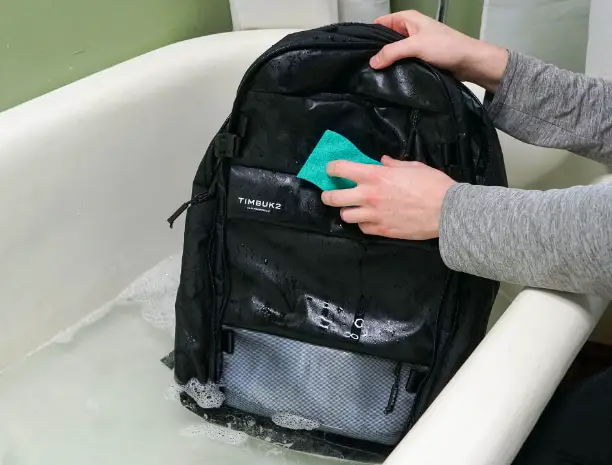A tool bag is an essential accessory for many professionals and hobbyists. From carpenters to mechanics, having a designated carrier for your equipment not only keeps things organized but also protects delicate tools from damage. However, after heavy use, tool bags can get extremely dirty – covered in sawdust, grease, dirt, and more.
Learning how to properly clean your tool bag is important to extend its life and keep your tools clean. This comprehensive guide will teach you how to clean all types of tool bags, from fabric to leather, using simple homemade cleaners and machine washing.
How To Clean All Types Of Tool Bag At Home
How to Clean a Fabric Tool Bag
Canvas and polyester are common materials used to make affordable, durable tool bags. Luckily, fabric tool bags can be cleaned easily with mild detergent or thrown right in the washing machine.
1. Clean Fabric Tool bag With Mild Detergent

For a basic cleaning, mix a few drops of dish soap or laundry detergent with warm water in a bucket. Use a sponge or soft brush to scrub the inside and outside of the tool bag, paying close attention to dirty spots. The detergent will lift grease, dirt, sawdust and stains from the fabric. Rinse the tool bag thoroughly with clean water to remove all suds and let air dry.
For tougher stains, rub a small amount of laundry detergent directly on the spot before soaking and scrubbing the whole bag. The agitation helps release deep set grime.
2. Cleaning Fabric Tool bag With Machine Washing
Canvas and polyester tool bags can be tossed right in the washing machine for an easy deep clean. Use cold water on a gentle cycle with mild detergent. If the tool bag is excessively dirty, do a short pre-wash cycle first to lift surface level grime and stains.
Make sure to fully unzip and unfold the tool bag before washing so all surfaces get cleaned. To help break up dirt, add a few towels to the machine to cushion the tools during the wash cycle.
Once the wash is complete, either line dry or tumble dry on low heat. The heat from the dryer can help restore a tool bag’s shape if it got bent out of place in the washer.
How To Clean a Canvas Tool Bag
Canvas is the classic fabric used to make tool bags and tool backpacks. Made from thick woven cotton or cotton-polyester blends, canvas is rugged and durable, perfect for hauling heavy tools. But the coarse natural fibers can trap dirt, dust and spills down in the weave. Follow these steps to clean even the dirtiest canvas tool bag:
- Start by fully emptying the bag and shaking out any loose debris. Use a small vacuum or brush to clean the nooks and crannies.
- Mix warm water and a few drops of dish soap in a bucket. Use a soft scrub brush or sponge to apply the soapy water to all surfaces of the canvas bag, both inside and out.
- Let the tool bag soak for 10-15 minutes so the soap can penetrate stains. Agitate periodically with the scrub brush.
- Once soaked, thoroughly rinse away all soap residue under running water.
- Allow the canvas tool bag to fully air dry before refilling with tools. Lay flat or hang to dry.
For serious grime, oily stains or mildew buildup, make this heavy duty canvas cleaner:
- 1/2 cup white vinegar
- 1/4 cup baking soda
- 1 tbsp hydrogen peroxide
- 1 tbsp liquid dish soap
Mix ingredients into a paste, apply to stained or dirty areas, let sit 15 minutes, then scrub clean and rinse. The vinegar disinfects, baking soda deodorizes, peroxide lifts stains and soap cuts grease.
How To Clean a Leather Tool Bag
Leather tool bags add a touch of classic style and rugged durability. Maintaining the supple feel of natural leather requires gentle cleaning methods compared to canvas or polyester.
Method 1 – Use Leather Cleaner

Specialized saddle soap or leather cleaning wipes easily remove dirt without damaging the finish. Gently wipe down the outside and inside of the leather tool bag. Buff dry with a soft cloth.
Method 2 – Use Saddle Soap

Traditional saddle soap contains oils to condition leather while lifting grime. Work a small amount of saddle soap into dirty leather with a horsehair brush in circular motions. Rinse clean and let dry completely.
Avoid over-wetting leather tool bags as excess water can cause stiffness, discolouration or mould. Make sure to thoroughly dry the inside of the bag after cleaning.
How To Remove Stains and Odors from the Tool Bag
Even after general cleaning, stubborn stains and funky odours can linger in a tool bag. Tackle these tough cleaning challenges with these DIY remedies:
Oily Stains – Remove greasy oil stains by sprinkling cornstarch or baking soda on the spot to absorb excess oil, then scrub with dish soap.
Paint Stains – Use rubbing alcohol or nail polish remover (acetone) applied with a cloth to break down stubborn paint.
Rust Stains – Make a paste from cream of tartar and lemon juice. Apply to rust spots, let sit for 15 minutes, then rinse clean. The acid lifts the iron oxide stains.
Mildew Odor – Deodorize musty tool bags by spraying white vinegar or lemon juice inside. Allow to air dry fully to remove moisture that feeds mildew.
Smoke Odor – An open box of baking soda in the tool bag will absorb lingering cigarette or campfire smoke smells. Replace regularly.
Fuel Spills – Gently dab fuel spills with baking soda to soak up liquid, then scrub with dish soap. Rinse thoroughly – don’t allow flammable liquids to remain.
Why is it necessary to clean a tool bag regularly?
Tool bags take a beating and can get dirty fast – but how often should you deep clean your bag? Follow these tips:
- Do a quick wipe-down after each use to remove sawdust, dirt and other debris.
- Every 1-2 months, do a thorough cleaning with soap and water. Disinfect the interior.
- Spot clean oily stains or leaks as soon as they occur so they don’t set in.
- At the end of a big job, wash heavy dirt and chemicals out completely.
- Clean a tool bag immediately if it gets contaminated with dangerous materials like lead dust or asbestos.
- Replace worn or damaged bags that cannot be restored with cleaning.
The cleaning frequency depends on usage and exposure to elements. For carpenters and contractors using their bag daily on messy job sites, a monthly deep cleaning is ideal. DIYers using a tool bag sporadically can stretch cleanings to every 3-6 months.
How To Dry the Tool Bag Properly
Drying is one of the most important steps when cleaning any tool bag. Leftover moisture encourages mold, warping, stains and rust:
- Always allow tool bags to fully air dry before storing. Don’t stash a damp bag.
- Unzip pockets and unfurl flaps so air circulates inside.
- Stuff paper towels or rags inside cavities to absorb excess water.
- Use a fan or dehumidifier to speed drying time if needed.
- For heavy canvas, you can tumble dry on low briefly to evaporate water hidden in the weave.
- Avoid drying leather tool bags in direct sunlight or high heat that can cause cracking.
- Make sure metal hardware, snaps and zippers are completely dry to prevent rusting.
It’s tempting to load tools back into use, but taking the time to completely dry your bag will keep both your bag and tools like new for years to come.
Conclusion
Tool bags are a smart investment for keeping gear organized, protected and portable. But even the most rugged designs require regular cleaning to stay functional.
Getting into the habit of quick cleanings after each use and monthly deep cleanings can extend the life of a quality tool bag for years. Always use mild, pH-balanced cleaners and take steps to fully dry before storage and reuse. With the proper care, your tool bag will provide service for all your construction, mechanical and hobby needs.
FAQ
How do you get oil stains out of a tool bag?
To remove oily stains from a tool bag, first blot up any excess oil with a rag. Coat the stain in cornstarch or baking soda to absorb remaining oil, then scrub the spot vigorously with dish soap and warm water. Rinse clean and allow to fully dry. Repeat if needed for tough stains. Avoid harsh chemicals that may degrade the bag’s fabric.
How do you clean the inside of a tool bag?
The inside of a tool bag takes a beating, so needs a deep clean every 1-2 months. First, remove all tools and debris. Vacuum out any dust or dirt. Then, using a bucket of warm water mixed with a few drops of mild dish soap, scrub the interior with a brush. Rinse thoroughly until all soap residue is gone. Allow to air dry fully with zippers open.
Should you wash tool bags in the washing machine?
Canvas, polyester and other synthetic fabric tool bags can be safely washed in the washing machine on a gentle cycle with cool water. Use mild detergent. Zip up the bag and add towels as cushioning during the wash. Line dry or tumble dry on low. Avoid washing leather tool bags this way.
How do you get mouldy smells out of a tool bag?
To remove musty mildew odours from a tool bag, start by washing with vinegar added to the detergent which helps kill mould spores. Allow it to dry fully in the sun. Then place an open box of baking soda or charcoal bag inside the bag to absorb odors overnight before storing tools again.
How often should you clean tool bags?
How often you clean a tool bag depends on usage:
- Heavy use (daily, construction) = Clean monthly
- Medium use (weekly, carpentry) = Clean every 2-3 months
- Light use (rarely, home DIY) = Clean every 6 months Do quick wipe-downs after each use to prevent buildup. Clean immediately if contaminated.
What’s the best way to dry out a tool bag after cleaning?
After washing a tool bag, allow it to fully air dry with zippers unzipped and flaps undone. Lay flat or hang to dry thoroughly. Use old rags or paper towels to soak up moisture inside pockets. Direct a fan at it to speed drying. Never store a damp tool bag as moisture promotes rust, mold and warping.
Can you put tool bags in the dryer?
Most fabric tool bags can be put in the dryer on a low or no heat setting after washing and rinsing clean. The heat will help dry out the material fully. Remove metal components first. Lay canvas bags flat to retain shape. Avoid drying leather bags this way. Air drying is best for leather.
How do you clean rust stains from a tool bag?
To remove stubborn rust stains from a tool bag, make a paste using cream of tartar and lemon juice. Apply paste to stained area, allow to sit 15 minutes, then scrub clean with a brush. The acid in the paste will lift and dissolve the rust stain. Rinse thoroughly. Avoid bleach or other harsh chemicals.
How can you extend the life of a tool bag?
Regular cleaning is key to getting the most years out of a quality tool bag. Quick wipe-downs after each use prevents buildup. Deep clean every 1-3 months with gentle soap and water. Spot clean spills immediately. Allow to fully air dry after washing. Store indoors away from moisture and sunlight. Repair damage like ripped seams right away.


